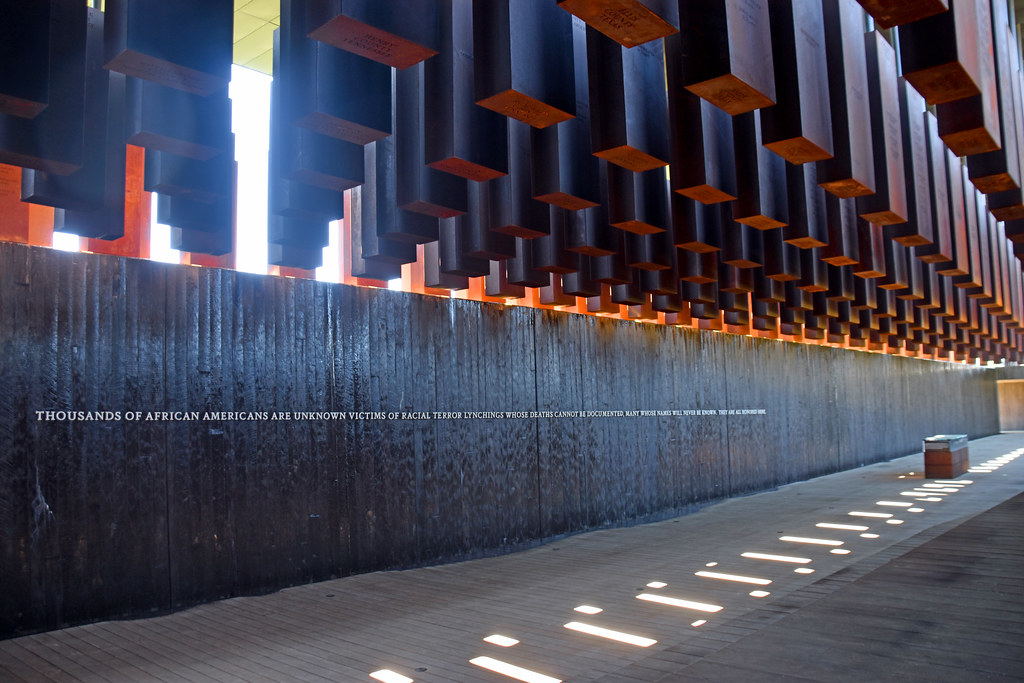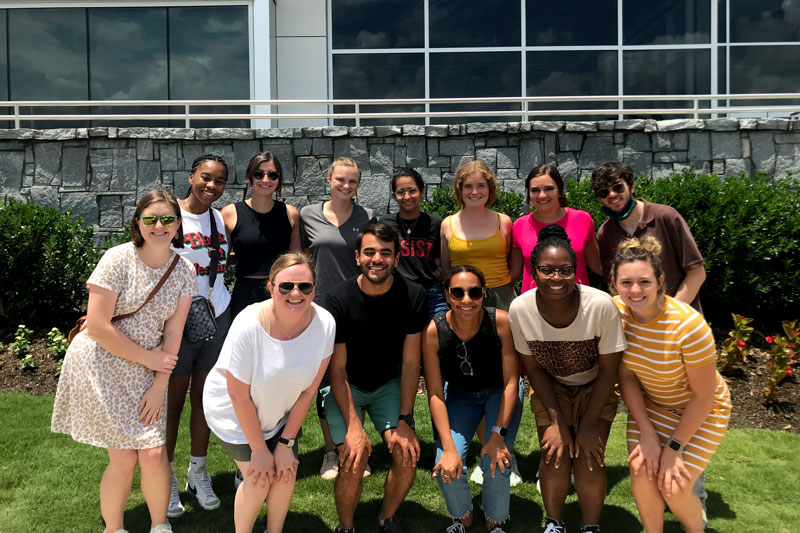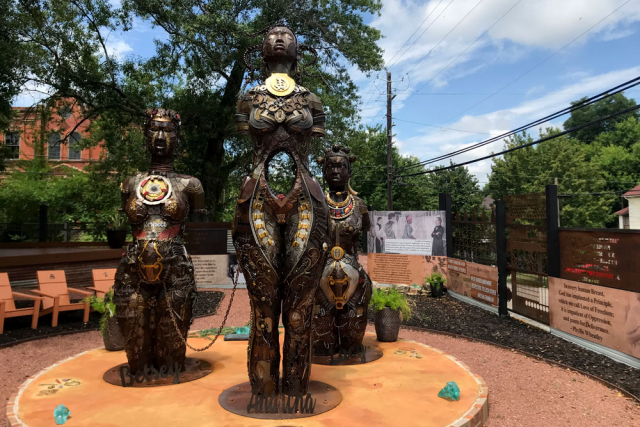 The National Memorial for Peace and Justice honors victims of lynching and racial terror. (Photo: Flickr Creative Commons)
The National Memorial for Peace and Justice honors victims of lynching and racial terror. (Photo: Flickr Creative Commons)
On a July morning that was already beginning to swelter, students, faculty and staff in the Department of Family Medicine’s Comprehensive Urban Underserved and Rural Experience, or CU2RE, program loaded onto a bus to make the hour-and-a-half trip from Birmingham to Montgomery.
On their itinerary that day were three museums and memorials: The National Memorial for Peace and Justice, The Legacy Museum and the Mothers of Gynecology Monument. Each of these sites sheds light on both the brutality of racism in the United States and the resilience of African Americans in this country. For medical students hoping to build their careers around providing primary care in underserved communities, these museums also hold important lessons about the cultural consciousness of racism in medicine and the socioeconomic barriers patients might face.
CU2RE student Amiria Blakely described it as a “journey of learning more about some of the heartbreaking and eye-opening truths of American history.”
“We will be able to use this knowledge to improve the care and treatment of those who have been consistently marginalized in medicine,” Blakely said. “As students and future physicians, being pre-exposed to all these topics allows us the opportunity to better manage situations when they arise and use our experience to assist our peers.”
 CU2RE students with Urban Underserved and Rural Pathways Director Jill Marsh, M.D., outside of the memorial.
CU2RE students with Urban Underserved and Rural Pathways Director Jill Marsh, M.D., outside of the memorial.
The Montgomery excursion was part of the CU2RE summer program, an eight-week program providing the 14 students in CU2RE's second cohort – rising second-year medical students across UAB’s four campuses – with a variety of in-person and virtual programming. In addition to visiting the museums in Montgomery, students engaged with the Race, Racism and Racialized medicine module and facilitated session and took part in a Birmingham landmarks tour with Shyla K. Fields, MBA, director of the department’s Office of Identity, Inclusion and Collective Conscience, focusing on cultural competency and understanding barriers to care. They also participated in workshops focused on leadership and interprofessional education, and in skills workshops and clinical experiences. You can read more about the full summer program here. The CU2RE program is now accepting applications from first-medical students. Interested students can learn more here.
In Montgomery, the day started with The National Memorial for Peace and Justice, a six-acre site created by the Equal Justice Initiative to memorialize thousands of known and unknown victims of lynching in the American South. Eight hundred six-foot metal monuments, inscribed with the names of known lynching victims in counties across the south, stand on a hillside or drop down from the memorial’s ceiling as visitors walk through, creating an immersive experience that uses art to visually move from the arrival of enslaved men and women in the U.S. to racial terror in the Jim Crow South to the Civil Rights Movement and ongoing fights for equality and justice today.
Just down the street from the memorial is the Mothers of Gynecology Monument. Created by founder and artist Michelle Browder, the monument honors three African American women, Anarcha, Lucy and Betsy, who were enslaved and subjected to medical experimentation without anesthesia by Montgomery doctor J. Marion Sims. Though Sims became known worldwide as the “father of gynecology,” the pain and suffering of the women who helped bring about his advances were less well-known. Browder works to celebrate those women and share their stories, especially with future medical practitioners like the CU2RE students. The monument includes three beautiful, larger-than-life sculptures of Anarcha, Lucy and Betsy that Browder created, each component carefully chosen for its symbolism and meaning. There is a surrounding garden with art exhibits and historical information, and Browder recently bought the nearby building that Sims used as a hospital, which she plans to turn into both a museum and an upstairs clinical space that can provide health care and education to the community.
 These sculptures by Michelle Browder honor three enslaved women, Anarcha, Lucy and Betsy, who endured medical experimentation, often without anesthesia.
These sculptures by Michelle Browder honor three enslaved women, Anarcha, Lucy and Betsy, who endured medical experimentation, often without anesthesia.
The CU2RE group ended the day at The Legacy Museum, which was also created by the Equal Justice Initiative and pairs with The National Memorial for Peace and Justice. The museum takes visitors chronologically from the beginning of slavery in America, including enslaved Africans’ harrowing journey across the Atlantic Ocean, through the Civil War, the abolition of slavery, the rise of Jim Crow and segregation, lynching and racial terror, the Civil Rights Movement and modern-day mass incarceration disproportionately affecting African Americans. The exhibits are thorough and immersive, from the virtual waves of the Atlantic Ocean that crash and tower above you in the first room to the phone booths in one of the final rooms, where you can pick up the phone and watch and listen as someone tells his or her story from prison.
As communications director, I joined the students for all three museums to get a sense of what they were experiencing and to learn from the exhibits and discussions. Like many of the CU2RE students, I grew up in Alabama. I was familiar with some of the history that the museums shared, such as the history of slavery and Civil Rights Movement, but completely unaware of other topics, such as the gynecological experiments Lucy, Anarcha and Betsy endured or the circumstances and atmosphere of racial terror created by the many lynchings across Alabama. I was most struck by the continued legacy of that violence and how it informs many of the problems we face today. I left further convinced of the importance of talking about this history and these problems openly and honestly so that we can take them on together as a department, a school and a community.
After visiting The Legacy Museum, we all boarded the bus bound for Birmingham, but the discussion didn't end there. The following day, Alluvial Collective led reflective sessions for youth, citizens, and communities. The week concluded with a reflection session between Cary Foutain, co-founder of The Black Cherry Tree Project, and Fields. Students viewed art and poetry memorializing 17 of 33 victims of lynching and racial terror in Jefferson County. A facilitated discussion followed on how the juxtaposition of art and medicine can shed light on and heal today's people through storytelling, intentionality, and caring for them as whole humans.
Students will continue to focus on disparities in medicine and social determinants of health throughout their time in the CU2RE program, with the ultimate goal of better understanding and meeting the needs of the communities where they will serve and creating medical practices that serve all patients well.